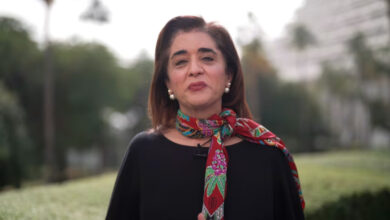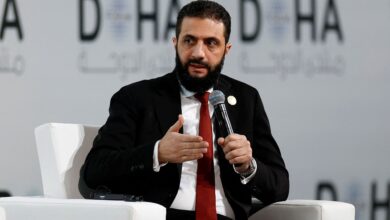
CAIRO (AP) — Was it real?
It’s all been erased so completely, so much blood has been shed and destruction wreaked over the past decade. The idea that there was a moment when millions across the Middle East wanted freedom and change so much that they took to the streets seems like romantic nostalgia.
“It was very brief, man. It was so brief,” said Badr Elbendary, an Egyptian activist.
Elbendary was blinded on the third day of his country’s revolt in 2011, when security forces shot him in the face. It happened during a clash that became iconic among Egypt’s “revolutionaries,” when protesters and police battled on a bridge over the Nile in Cairo for hours, ending with the police scattering.
Today, he’s in the United States. He can’t return home. Many of his comrades from the protests languish in prisons in Egypt.
In December 2010, the uprising began in Tunisia and quickly spread from country to country in revolts against longtime authoritarian rulers. It became known as the Arab Spring, but for those who took to the streets, the call was “revolution.”
The uprisings were about more than just removing autocrats. At their heart, they were a mass demand by the public for better governance and economies, rule of law, greater rights and, most of all, a voice in how their countries are run.
For a time after 2011, the surge toward those dreams seemed irreversible. Now they are further than ever. Those who keep the faith are convinced that yearning was real and remains — or is even growing as people across the Arab world struggle with worsening economies and heavier repression. Eventually, they say, it will emerge again.
“We have lowered our dreams,” said Amani Ballour, a Syrian doctor who ran an underground clinic treating casualties in the opposition enclave of Ghouta outside Damascus until it collapsed under a long, brutal siege by Syrian government forces in 2018. She was evacuated with other residents to northwest Syria, and from there she left the country.
“The spirit of the demonstrations may be over for now … But all those who suffered from the war, from the regime’s repression, they won’t put up with it,” she said from Germany. “Even in the areas controlled by the regime, there is great frustration and anger building up among the people.”
“Eventually” could be years.
The region is traumatized and exhausted by its most destructive decade of the modern era, perhaps the most destructive in centuries.
Across Syria, Yemen and Iraq, millions have lost their homes in war and struggle to find livelihoods, educate their children or even to feed themselves. Armed factions have proliferated in those countries and Libya, raking in money and recruiting young people who find few other options. Poverty rates have risen around the region, especially with the coronavirus pandemic.
Activists and analysts have had a decade to pore over why it went wrong.
Secular liberals failed to present a cohesive front or leadership. Islamists like the Muslim Brotherhood overplayed their hand. Labor organizations, neutered by decades of autocratic rule, couldn’t step up as a powerful mobilizer or political force. It’s perhaps no coincidence that the countries with some success, Tunisia and Sudan, both had strong labor and professional movements.
The international scene was pitted against the uprisings. The United States and Europe were muddled in their responses, torn between their rhetoric about backing democracy and their interest in stability and worries about Islamists. In the end, they largely listened to the latter.
Gulf monarchies used oil wealth to smother any revolutionary tide and back reactionary powers. Russia, Iran, Turkey and the United Arab Emirates waded into the region’s wars, either sending their own forces or arming factions.
Ultimately, few expected just how wide some leaders were willing to throw open the gates of Hell to keep power.
Syria’s Bashar Assad proved the most ruthless. Faced with armed rebellion, he and his Russian and Iranian allies decimated cities, and he used chemical weapons on his own people, clawing back Syria’s heartland and main cities and preserving his rule.
In Yemen, strongman Ali Abdullah Saleh was forced to step down in late 2011 in the face of the protests. But he soon tried to regain power by allying with his longtime enemy, the Iranian-backed Shiite Houthi rebels. Together, they captured the capital and Yemen’s north, pulling Saudi Arabia and other Gulf countries into a U.S.-backed campaign to rescue the government.
The resulting civil war has been catastrophic, killing tens of thousands and pushing the population toward starvation in the world’s worst ongoing humanitarian disaster. Saleh himself was killed by the Houthis when they suspected him of turning on them.
In Libya, the US and European countries retreated from involvement after their bombardment helped bring down Moammar Gadhafi. The oil-rich Mediterranean nation promptly collapsed into a constantly shape-shifting civil war. Over the years, it has involved the many local militias, units of the old national army, al-Qaida, the Islamic State group, Russian mercenaries and Turkish-backed Syrian fighters, with at least two — at one point three — rival claimant governments.
Europe’s main priority has been to stop the flow of African migrants from Libya across the Mediterranean. So Libya has become a horrific dead end for thousands of men and women trying to migrate from Central and East Africa only to find themselves locked up and tortured by militiamen.
Syria’s civil war gave al-Qaida’s former Iraq branch, rebranded as the Islamic State group, a theater in which to build strength. From there it overran a swath of Syria and Iraq and declare the creation of an Islamic “caliphate” — opening up yet another war that wreaked destruction in Iraq.
In Egypt, President Abdel-Fattah el-Sissi often points to the wreckage around the region to bolster one of his key claims to legitimacy — “without me, chaos.”
El-Sissi has taken the lesson from 2011 that even the slightest opening gives a foothold for turmoil, often saying stability is needed while he reshapes the economy. It’s an argument that resonates among many Egyptians, shaken not only by wars in Syria and Libya but also Egypt’s turmoil for years after Hosni Mubarak’s fall.
The result has been repression of dissent far beyond what was seen under Mubarak. The crushing of the Muslim Brotherhood and Islamists included a brutal attack on a sit-in that left hundreds dead. In recent years, his government has arrested secular activists and others, often bringing them before terrorism court.
Still, even with much of the region deep in the counter-Arab Spring era, uprisings for change erupt.
Massive protests spread around Lebanon and Iraq in late 2019 and early 2020, with crowds demanding entire ruling classes be removed.
In Sudan, protesters forced out longtime autocrat Omar al-Bashir. Learning a lesson from 2011, they kept up their protests, trying to dislodge the military from power as well. They were only partially successful.
Those revolts point to how the ambitions of the initial uprisings still echo around the region. But for the time being, even incremental change often seems too much to hope for.
Rather than real democracy, “my dream before I die is to see less torture, fewer arrests, and a real, better economy,” said Ramy Yaacoub, who was involved in Egypt’s protests and post-revolution politics during the heady days after Mubarak’s fall.
“This is as realistic as I can be.”
“Change is not overnight. I don’t want to be all wonky and say the French Revolution took decades, but it did. It doesn’t happen over a year or two,” said Yaacoub, who founded and now heads the Tahrir Institute for Middle East Studies in Washington.
Some activists have turned to improving themselves, studying and building skills, keeping away despair.
Elbendary has regained partial sight in one eye — though he said it jarred him after getting accustomed to blindness. In the years since leaving Egypt, he has been doing consulting work on community organizing, policy research, independent media development and conflict resolution around the region. A brief visit home to Egypt in late 2018 and early 2019 made it clear it wasn’t safe for him to stay.
Now in Washington, he wrestles with exile. He still celebrates the uprising as “my rebirth” in his Twitter bio. The hope lies with a generation gaining knowledge that can one day benefit their homelands.
But when?
Several years at the most optimistic, he said — not for real change, “for a slight opening, a slight margin where we can breathe.”




